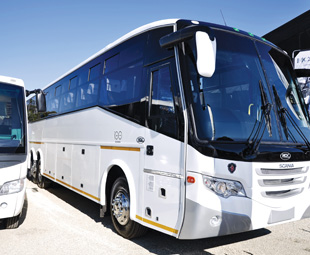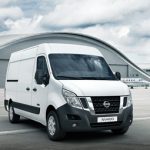Big, beautiful buses

Various bus chassis and body manufacturers exhibited at the Johannesburg International Motor Show’s growing Bus and Truck Show. Here are a few highlights.
MCV
Egyptian bus manufacturer MCV has only been in the South African market for three years. Although it has had an African export presence for far longer, these units have only been the left-hand drive versions manufactured in Egypt. The local operation has now developed right-hand drive versions in conjunction with De Haas, with two of its newest products shown at JIMS: the 70-seater (2×3 configuration, without toilet) S140R coach; and the 60-seater (2×3 configuration) S125R.
Key to the design of the MCV range is the use of standardised parts to cut costs and minimise downtime in the event of replacement. MCV has recently opened a factory in Cape Town, where the bodies are being built. By 2012, the company expects 85 to 90% local content in its products, creating 250 more jobs. The sales and after-sales operation is based in Johannesburg, but the after-sales network extends throughout Africa.
MCV is hoping its products will break through the low volume/high competition nature of the local market and is aiming to be a major player in the replacement bus market, as 80% of units operating in South Africa are now over 15 years old.
Scania
Scania was proud to celebrate 100 years in the bus and coach market at JIMS this year. The “Nordmark” was where it all started for Scania (then Scania-Vabis), with its chain-driven chassis being built by Scania in a factory in the south of Sweden, and the body and engine coming from Vabis. By 1932, Scania was producing more buses than trucks, and by the 1980s it was placing a big focus on public transport.
Alternative fuels have always been important for Scania, which has now developed its third-generation ethanol-powered bus. In the 1980s Scania Sweden started developing bio-fuelled engines, and the company upgraded its operation to include the manufacture of ED95 fuel, specifically for the ethanol-powered units.
ED95 is a blend of 95% ethanol and 5% ignition improver, denaturing agent and anti-corrosive additive. It can only be used in specially-modified diesel engines, and today there are over 700 buses running on ED95 in Sweden, most notably in Stockholm.
These models could make their way to South Africa in the near future. One, currently on a 15-month trial with Metrobus, has so far covered 35 000 km.
TATA
The India-based company brought familiar faces to the show, but did announce that newer models are in the pipeline. The TATA LPO1623 RE LE Starbus stood proud at the TATA stand in bright orange, equipped with a Cummins BS-IV engine. The Starbus 34 Ultra, powered by an inline four-cylinder engine, was also on show, again in bright orange. The bodies on these models are designed by Marcopolo, a company that TATA has partnered with in its ongoing attempts to improve its buses. Last, but not least, was the LPO 1823 Starbus 65 Commuter, the top of TATA’s range.
VDL
Perhaps little known to the South African market is VDL Bus and Coach, a Dutch-based company. Thirty percent of the SA operation is locally-owned, while the parent company controls 70%. Assembly takes place in Durban and VDL’s head office is in Isando, with service centres around South Africa.
VDL specialises in front engine designs, but the company is currently developing a rear-engined low entry chassis for the South African market. VDL offers a 4×2 and 6×2 chassis, making use of DAF engines and Voith Automated Manual Transmissions. The vehicles are equipped with EBS and ASR for improved brake-force distribution.
Published by
Focus on Transport
focusmagsa



